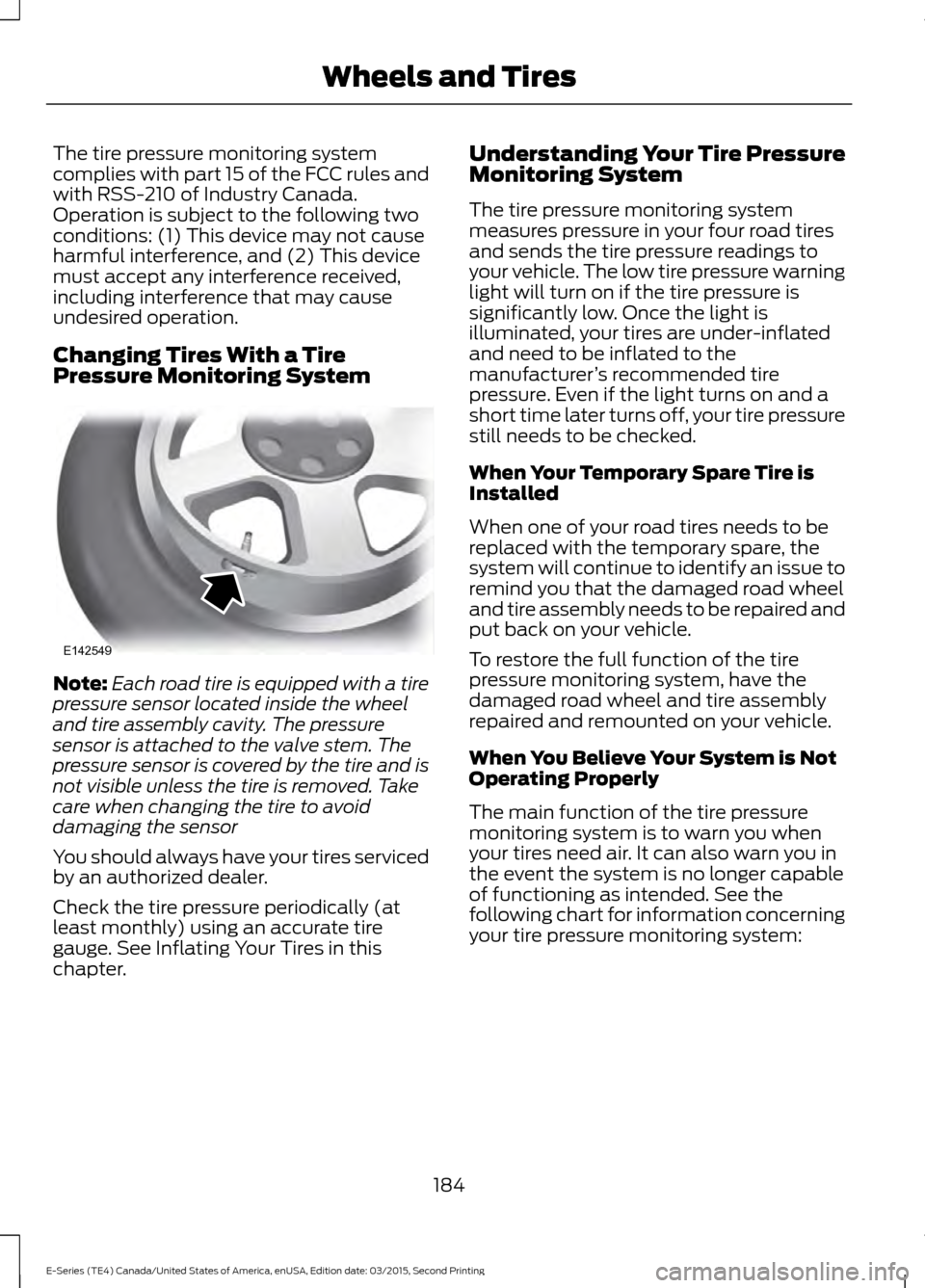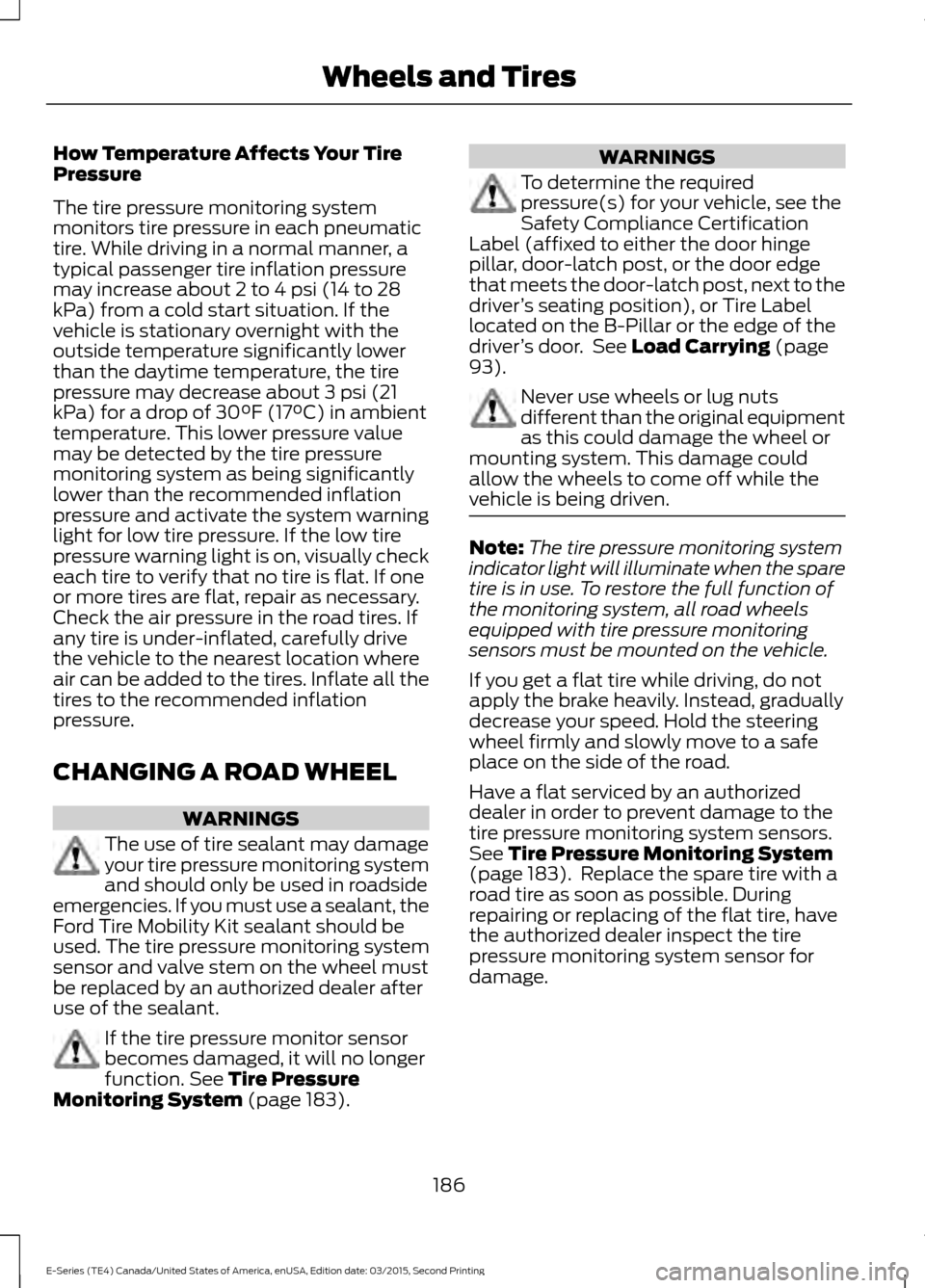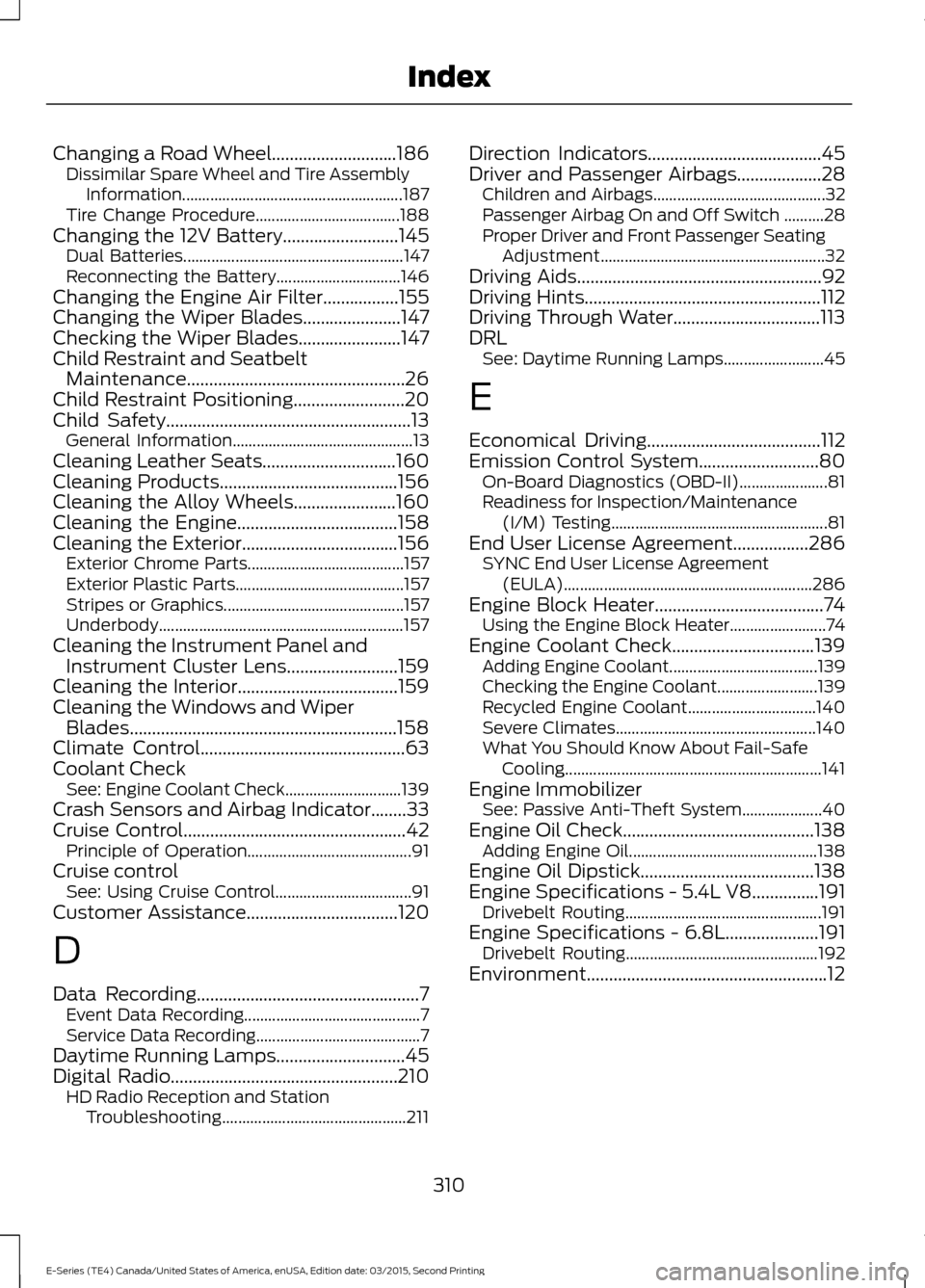sensor FORD E SERIES 2016 4.G User Guide
[x] Cancel search | Manufacturer: FORD, Model Year: 2016, Model line: E SERIES, Model: FORD E SERIES 2016 4.GPages: 319, PDF Size: 6.18 MB
Page 187 of 319

The tire pressure monitoring system
complies with part 15 of the FCC rules and
with RSS-210 of Industry Canada.
Operation is subject to the following two
conditions: (1) This device may not cause
harmful interference, and (2) This device
must accept any interference received,
including interference that may cause
undesired operation.
Changing Tires With a Tire
Pressure Monitoring System
Note:
Each road tire is equipped with a tire
pressure sensor located inside the wheel
and tire assembly cavity. The pressure
sensor is attached to the valve stem. The
pressure sensor is covered by the tire and is
not visible unless the tire is removed. Take
care when changing the tire to avoid
damaging the sensor
You should always have your tires serviced
by an authorized dealer.
Check the tire pressure periodically (at
least monthly) using an accurate tire
gauge. See Inflating Your Tires in this
chapter. Understanding Your Tire Pressure
Monitoring System
The tire pressure monitoring system
measures pressure in your four road tires
and sends the tire pressure readings to
your vehicle. The low tire pressure warning
light will turn on if the tire pressure is
significantly low. Once the light is
illuminated, your tires are under-inflated
and need to be inflated to the
manufacturer
’s recommended tire
pressure. Even if the light turns on and a
short time later turns off, your tire pressure
still needs to be checked.
When Your Temporary Spare Tire is
Installed
When one of your road tires needs to be
replaced with the temporary spare, the
system will continue to identify an issue to
remind you that the damaged road wheel
and tire assembly needs to be repaired and
put back on your vehicle.
To restore the full function of the tire
pressure monitoring system, have the
damaged road wheel and tire assembly
repaired and remounted on your vehicle.
When You Believe Your System is Not
Operating Properly
The main function of the tire pressure
monitoring system is to warn you when
your tires need air. It can also warn you in
the event the system is no longer capable
of functioning as intended. See the
following chart for information concerning
your tire pressure monitoring system:
184
E-Series (TE4) Canada/United States of America, enUSA, Edition date: 03/2015, Second Printing Wheels and TiresE142549
Page 189 of 319

How Temperature Affects Your Tire
Pressure
The tire pressure monitoring system
monitors tire pressure in each pneumatic
tire. While driving in a normal manner, a
typical passenger tire inflation pressure
may increase about 2 to 4 psi (14 to 28
kPa) from a cold start situation. If the
vehicle is stationary overnight with the
outside temperature significantly lower
than the daytime temperature, the tire
pressure may decrease about 3 psi (21
kPa) for a drop of 30°F (17°C) in ambient
temperature. This lower pressure value
may be detected by the tire pressure
monitoring system as being significantly
lower than the recommended inflation
pressure and activate the system warning
light for low tire pressure. If the low tire
pressure warning light is on, visually check
each tire to verify that no tire is flat. If one
or more tires are flat, repair as necessary.
Check the air pressure in the road tires. If
any tire is under-inflated, carefully drive
the vehicle to the nearest location where
air can be added to the tires. Inflate all the
tires to the recommended inflation
pressure.
CHANGING A ROAD WHEEL
WARNINGS
The use of tire sealant may damage
your tire pressure monitoring system
and should only be used in roadside
emergencies. If you must use a sealant, the
Ford Tire Mobility Kit sealant should be
used. The tire pressure monitoring system
sensor and valve stem on the wheel must
be replaced by an authorized dealer after
use of the sealant. If the tire pressure monitor sensor
becomes damaged, it will no longer
function. See Tire Pressure
Monitoring System (page 183). WARNINGS
To determine the required
pressure(s) for your vehicle, see the
Safety Compliance Certification
Label (affixed to either the door hinge
pillar, door-latch post, or the door edge
that meets the door-latch post, next to the
driver ’s seating position), or Tire Label
located on the B-Pillar or the edge of the
driver ’s door. See
Load Carrying (page
93). Never use wheels or lug nuts
different than the original equipment
as this could damage the wheel or
mounting system. This damage could
allow the wheels to come off while the
vehicle is being driven. Note:
The tire pressure monitoring system
indicator light will illuminate when the spare
tire is in use. To restore the full function of
the monitoring system, all road wheels
equipped with tire pressure monitoring
sensors must be mounted on the vehicle.
If you get a flat tire while driving, do not
apply the brake heavily. Instead, gradually
decrease your speed. Hold the steering
wheel firmly and slowly move to a safe
place on the side of the road.
Have a flat serviced by an authorized
dealer in order to prevent damage to the
tire pressure monitoring system sensors.
See
Tire Pressure Monitoring System
(page 183). Replace the spare tire with a
road tire as soon as possible. During
repairing or replacing of the flat tire, have
the authorized dealer inspect the tire
pressure monitoring system sensor for
damage.
186
E-Series (TE4) Canada/United States of America, enUSA, Edition date: 03/2015, Second Printing Wheels and Tires
Page 242 of 319

Note:
The driver is ultimately responsible
for the safe operation of the vehicle, and
therefore, must evaluate whether it is safe
to follow the suggested directions. Any
navigation features provided are only an aid.
Make your driving decisions based on your
observations of local conditions and existing
traffic regulations. Do not follow the route
suggestions if doing so would result in an
unsafe or illegal maneuver, place you in an
unsafe situation, or if you would be directed
into an area that you consider unsafe. Maps
used by this system may be inaccurate
because of errors, changes in roads, traffic
conditions or driving conditions. Note:
When you connect, the service uses
GPS technology and advanced vehicle
sensors to collect your vehicle's current
location, travel direction and speed to help
provide you with the directions, traffic
reports, or business searches you request.
Further, to provide the services you request,
for continuous improvement, the service
may collect and record call details and voice
communications. For more information, see
SYNC Services Terms and Conditions at
www.SYNCMyRide.com. If you do not want
Ford or its service providers to collect your
vehicle travel information or other
information identified in the Terms and
Conditions, do not subscribe or use the
service.
SYNC Services uses advanced vehicle
sensors, integrated GPS technology and
comprehensive map and traffic data, to
give you personalized traffic reports,
precise turn-by-turn directions, business
search, news, sports, weather and more.
For a complete list of services, or to learn
more, please visit www.SYNCMyRide.com.
Connecting to SYNC Services Using Voice Commands
Press the voice button and when prompted say: Action and Description
Voice command
This initiates an outgoing call to SYNC Services using your
paired and connected Bluetooth-enabled cellular phone.
Services
Once you connect to the service, follow the voice prompts
to request the desired service, for example traffic or directions.
Once you are connected to SYNC Services, you can also say the following: Receive a list of available services from which to choose.
(what are my (options |
choices) | what can I say
| [available] commands)
239
E-Series (TE4) Canada/United States of America, enUSA, Edition date: 03/2015, Second Printing SYNC™
Page 313 of 319

Changing a Road Wheel............................186
Dissimilar Spare Wheel and Tire Assembly
Information....................................................... 187
Tire Change Procedure.................................... 188
Changing the 12V Battery..........................145
Dual Batteries....................................................... 147
Reconnecting the Battery............................... 146
Changing the Engine Air Filter.................155
Changing the Wiper Blades
......................147
Checking the Wiper Blades.......................147
Child Restraint and Seatbelt Maintenance.................................................26
Child Restraint Positioning.........................20
Child Safety
.......................................................13
General Information............................................. 13
Cleaning Leather Seats..............................160
Cleaning Products
........................................156
Cleaning the Alloy Wheels.......................160
Cleaning the Engine....................................158
Cleaning the Exterior...................................156 Exterior Chrome Parts....................................... 157
Exterior Plastic Parts.......................................... 157
Stripes or Graphics............................................. 157
Underbody............................................................. 157
Cleaning the Instrument Panel and Instrument Cluster Lens.........................159
Cleaning the Interior....................................159
Cleaning the Windows and Wiper Blades............................................................158
Climate Control
..............................................63
Coolant Check See: Engine Coolant Check............................. 139
Crash Sensors and Airbag Indicator........33
Cruise Control..................................................42 Principle of Operation......................................... 91
Cruise control See: Using Cruise Control.................................. 91
Customer Assistance
..................................120
D
Data Recording
..................................................7
Event Data Recording............................................ 7
Service Data Recording......................................... 7
Daytime Running Lamps.............................45
Digital Radio
...................................................210
HD Radio Reception and Station
Troubleshooting.............................................. 211Direction Indicators
.......................................45
Driver and Passenger Airbags...................28 Children and Airbags........................................... 32
Passenger Airbag On and Off Switch ..........28
Proper Driver and Front Passenger Seating Adjustment........................................................ 32
Driving Aids.......................................................92
Driving Hints.....................................................112
Driving Through Water.................................113
DRL See: Daytime Running Lamps......................... 45
E
Economical Driving
.......................................112
Emission Control System...........................80 On-Board Diagnostics (OBD-II)...................... 81
Readiness for Inspection/Maintenance (I/M) Testing...................................................... 81
End User License Agreement.................286 SYNC End User License Agreement
(EULA).............................................................. 286
Engine Block Heater......................................74 Using the Engine Block Heater........................ 74
Engine Coolant Check
................................139
Adding Engine Coolant..................................... 139
Checking the Engine Coolant......................... 139
Recycled Engine Coolant................................ 140
Severe Climates.................................................. 140
What You Should Know About Fail-Safe Cooling................................................................ 141
Engine Immobilizer See: Passive Anti-Theft System.................... 40
Engine Oil Check...........................................138 Adding Engine Oil............................................... 138
Engine Oil Dipstick.......................................138
Engine Specifications - 5.4L V8
...............191
Drivebelt Routing................................................. 191
Engine Specifications - 6.8L.....................191 Drivebelt Routing................................................ 192
Environment......................................................12
310
E-Series (TE4) Canada/United States of America, enUSA, Edition date: 03/2015, Second Printing Index